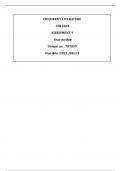CHILDREN’S LITERATURE
CHL2601
ASSESSMENT 9
Year module
Unique no : 783859
Due date :2023 /08/24
,
Question 1
1.1 Outline the difference between home language level, mother tongue or home language and
first additional language level in relation to its use as a language of learning and teaching in
South African schools. (6)
Home language level refers to the language that a learner speaks and understands at home.
Mother tongue or home language refers to the language that a learner acquires from birth or
early childhood, usually spoken by their parents or caregivers. First additional language level,
on the other hand, is a language learned as an additional subject in school.
In South African schools, the difference between these levels is crucial for language of learning
and teaching. Home language level is the ideal medium of instruction, as learners are most
comfortable and proficient in it. Mother tongue or home language level is similar but may include
dialectal variations. First additional language level is taught to enhance learners' linguistic skills,
but it may not be used as the primary medium of instruction.
Choosing the appropriate language of instruction is essential for effective learning outcomes, as
it influences comprehension, engagement, and academic performance. In South Africa, there is
a focus on promoting multilingualism and recognizing the importance of different languages in
, education. The goal is to provide quality education while respecting the linguistic diversity of the
country.
1.2 How is the additive approach implemented in South African schools to promote
multilingualism?
The additive approach to promoting multilingualism in South African schools is implemented
through various strategies. Firstly, schools aim to value and recognize the linguistic diversity of
their students by acknowledging and incorporating multiple languages into the curriculum.
One way this is done is through the provision of mother tongue education. Students are
encouraged to develop and maintain proficiency in their home language while also learning
additional languages. This approach recognizes the importance of a strong foundation in the
mother tongue for cognitive development and academic success.
In addition, schools may offer language classes or language enrichment programs that allow
students to learn additional languages beyond their mother tongue. This helps to foster a sense
of linguistic and cultural appreciation among students.
Furthermore, schools may promote the use of multiple languages in classroom instruction.
Teachers are encouraged to use a translanguaging approach, where they strategically and
purposefully integrate different languages to support students' understanding and learning.
Overall, the additive approach in South African schools aims to promote multilingualism by
valuing and incorporating multiple languages into the education system, supporting mother
tongue education, offering language classes, and encouraging the use of multiple languages in
classroom instruction.
1.3What is the difference between bibliotherapy and a bibliography?
Bibliotherapy and a bibliography are two different concepts related to books and reading, but
they serve different purposes:





